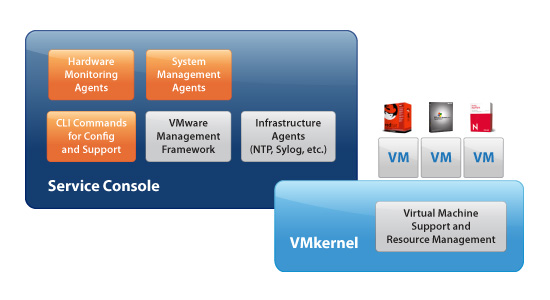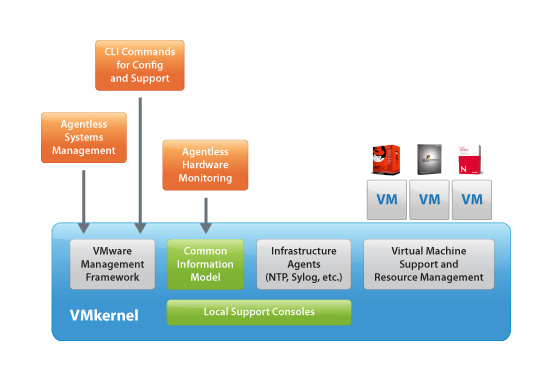Difference between VMware ESX and ESXi
VMware ESX
ESX (Elastic Sky X) is the VMware’s enterprise server virtualization platform. In ESX, VMkernel is the virtualization kernel which is managed by a console operating system which is also called as Service console. Which is linux based and its main purpose is it to provide a Management interface for the host and lot of management agents and other thrid party software agents are installed on the service console to provide the functionalists like hardware management and monitoring of ESX hypervisor. 
VMware ESXi
ESXi (Elastic sky X Integrated) is also the VMware’s enterprise server virtualization platform. In ESXi, Service console is removed. All the VMware related agents and third party agents such as management and monitoring agents can also run directly on the VMkernel. ESXi is ultra-thin architecture which is highly reliable and its small code-base allows it to be more secure with less codes to patch. ESXi uses Direct Console User Interface (DCUI) instead of a service console to perform management of ESXi server. ESXi installation will happen very quickly as compared to ESX installation.

Improve Reliability and Security
The ESX architecture available in releases prior to vSphere 5.0 relied on a Linux-based COS for serviceability and agent-based partner integration. In the new, operating-system independent ESXi architecture, the approximately 2 GB COS has been removed and the necessary management functionality has been implemented directly in the core VMkernel. Eliminating the COS drastically reduces the install footprint of the vSphere ESXi hypervisor to approximately 150 MB improving security and reliability by removing the security vulnerabilities associated with a general purpose operating system.
Streamline Deployment and Configuration
The new ESXi architecture has far fewer configuration items greatly simplifying deployment and configuration and making it easier to maintain consistency.
Reduce Management Overhead
The API-based partner integration model of the ESXi architecture eliminates the need to install and manage third party management agents. You can automate routine tasks by leveraging remote command line scripting environments such as vCLI or PowerCLI.
Simplify Hypervisor Patching and Updating
Due to its small size and limited components, the ESXi architecture requires far fewer patches than early versions, shortening service windows and reducing security vulnerabilities. Over its lifetime, the ESXi architecture requires approximately 10 times fewer patches than the ESX hypervisor running with the COS.
Comparing the Legacy and New vSphere Architectures
| Refer |


